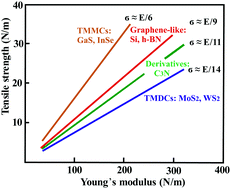Predictive modeling of intrinsic strengths for several groups of chemically related monolayers by a reference model
Abstract
The linear correlation between the ratios of linear and nonlinear intrinsic mechanical properties allows the prediction of largely unknown nonlinear fracture properties of brittle two-dimensional (2D) solids using a reference model. It is demonstrated that from accurately known Young's moduli unknown theoretical strengths can be derived. The predictive power of the reference model for the systematic evaluation of the fundamental mechanical behavior of whole groups of compounds with chemically-related configurations is shown. This is revealed for graphene-like atomic monolayers, various derivatives of graphene, transition-metal dichalcogenide (TMDC), and transition-metal monochalcogenide (TMMC) molecular monolayers of the fast growing family of 2D solids. The estimated unknown intrinsic strengths represent the upper limits for the mechanical performance of 2D compounds and can be used to judge the actual deviations between real monolayers and their ideal counterparts. A detailed comparison of the reference model with existing experiments and density functional theory (DFT) calculations confirmed that the ratios of Young's moduli and intrinsic strengths reach a factor of ∼6 for strongly bonded TMMCs, the bulk value of ∼9 for graphene-like monolayers, ∼11 for graphene derivatives, whereas for transition-metal dichalcogenide (TMDC) monolayers the ratio is ∼13.5. With its minimal requirement of mechanical input data and its versatility the reference model provides a unique tool to predict unknown nonlinear mechanical properties.



 Please wait while we load your content...
Please wait while we load your content...